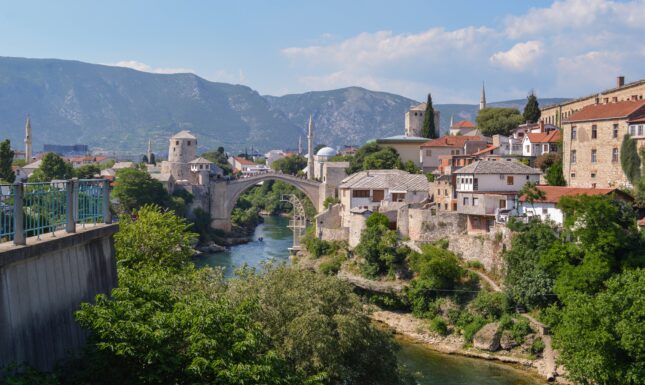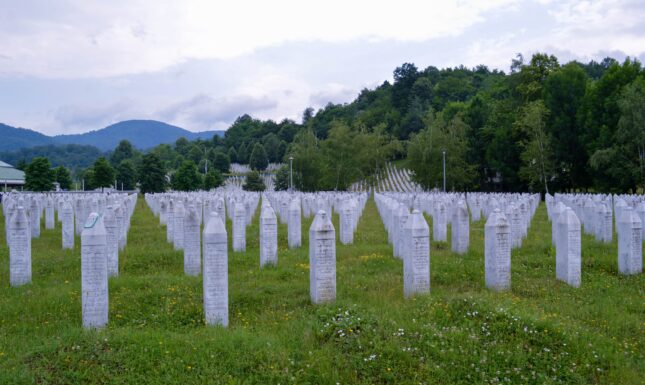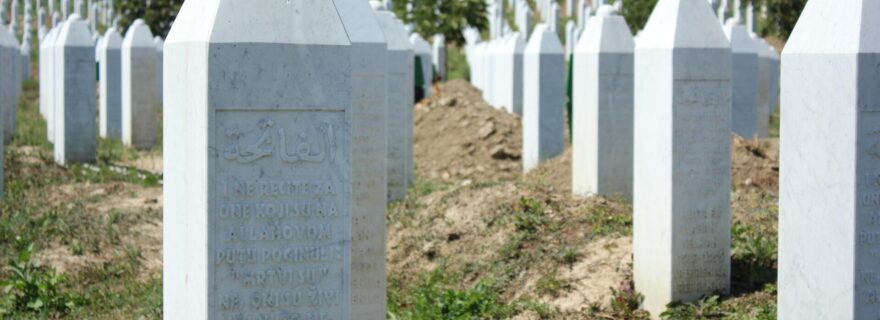In search of justice: Leiden and Sarajevo students exploring the meaning of justice in post-war Bosnia and Herzegovina
Every nation has its own dark chapters of history and the Netherlands and Bosnia-Herzegovina are no exception. Could the rule of law help in bringing closure?
Introduction
Every nation has its own dark chapters of history and the Netherlands and Bosnia and Herzegovina are no exception. In the Honours College Law course “Using the rule of law to close dark chapters of history? The case of Bosnia and Herzegovina” it was asked whether the rule of law can help in bringing closure.
This course focused on the Bosnian war of 1992-1995, specifically the Srebrenica genocide of July 1995 during which more than 8000 Muslim men and boys were massacred by the forces of the Bosnian-Serb forces, despite the presence of the UN Dutch battalion troops (Dutchbat) responsible for safeguarding the enclave of Srebrenica.
In June 2022, a diverse group of BA, MA, and PhD students, all with different academic and cultural backgrounds – from anthropology to law, from Indonesia to Syria to Italy – explored Bosnia-Herzegovina during a study trip in the context of the course. Under the guidance of our teacher, Nadia Sonneveld, we visited Sarajevo, Srebrenica, and Mostar.
In such a context, the obvious question for a law student arises: has justice been served? And, maybe an even more important question: who decides this? One can recall the conviction of Ratko Mladić, also known as the Butcher of Srebrenica, who was found guilty by trial in The Hague. The judge of the International Criminal Court for the Former Yugoslavia had spoken, ergo, according to the rule of law, justice has been served. However, do the people in Bosnia-Herzegovina agree? Did this and other legal rulings usher in the beginning of a new era of harmonious co-existence between the three main groups embroiled in the war: Bosnian-Serbs, Bosniaks (Bosnian Muslims), and Bosnian-Croats? Relevant questions; even though it has been 30 years since the genocide took place, the events are still very much alive, both in Bosnia-Herzegovina, and in the Netherlands.
It was our purpose to experience for ourselves whether, in the aftermath of the war, the Bosnian people feel that justice has been served. After all, the UN has never been legally held accountable for what happened due to its immunity from the jurisdiction of national courts. Additionally, a significant number of alleged war criminals have still not been put to trial, and even after almost three decades many victims are still missing. Only a day after our return from Bosnia-Herzegovina, the Dutch government apologised to hundreds of ex-Dutchbat soldiers sent to defend Srebrenica during the Bosnian war. A month later, on 11 July 2022, during the annual commemoration of the Srebrenica genocide in Potočari, the Dutch government offered its deepest apologies to the survivors of the genocide. The study trip took place on the eve of these events.
Sarajevo: A European crossroads
I had already seen it from the rickety propeller plane on the way in; Sarajevo is tucked into a valley surrounded by densely wooded mountains. On our first day, our guide, Said, a master’s student of the University of Sarajevo, vividly explained in front of a Catholic cathedral how Bosnian-Serb troops had shelled his city from the mountains for almost four years. Parts of its walls still bullet-ridden, the cathedral was a silent witness of all the violence that had taken place. The concrete scar as a result from a grenade explosion that hit the premises of the church during the Siege of Sarajevo was later filled with red resin: a big Sarajevo Rose as another testimony of the lives taken.
But the wounded place also taught us something important about the diversity of Bosnia-Herzegovina and its rich cultural history. The central location of Bosnia-Herzegovina makes the country a crossroads for the many turns of European history. In the centre, you stand with one foot in the Austrian-Hungarian part of the city and with the other in its Ottoman part. Walking along the main street from one part to the other is a smooth transition of architecture, food, and smells, giving the centre an interesting and exciting composition. We walked in a radius of approximately 100 metres from the big Catholic cathedral to a beautiful mosque and a historical synagogue. From the synagogue we had a view over the Old Jewish Cemetery, the second largest graveyard of its kind in Europe. The Jews peacefully co-existed with their Christian and Muslim neighbours in Sarajevo and elsewhere in Bosnia-Herzegovina. The same applied to the Bosnian-Serbs, Bosniaks, and Bosnian-Croats. How come the harmonious composition broke, with genocide as a result?


Srebrenica
A three-hour drive took us from Sarajevo to Potočari, the place where the Dutch UN enclave was based, just 10 kilometres away from the town of Srebrenica (a proclaimed UN Safe Area during the war). When we arrived, the Friday prayer at the memorial graveyard had already started. We strolled through the graveyard, located in the middle of enormous vast green meadows. Together with the beautiful sounds of the Friday prayer in the background, it made a peaceful sight, contrasting to the cruel massacres of the buried 8000 men and boys.
Later that day, we watched footage made by the Bosnian Serbs themselves while performing the executions. We saw a triumphantly smiling Ratko Mladić, telling a fearful group of Bosnian Muslims that all would be just fine. Watching the film with the knowledge of his conviction, still made it seem impossible for me to forgive, forget, and focus on the reconstruction of a broken society. However, the volunteers of the civil service centre nearby, who later that day warmly welcomed us with a traditional Bosnian meal, gave us a different perspective.
Awaiting us with three kittens and a puppy, the ladies of the International Forum of Solidarity explained how the centre provides food, clothes, and accommodation for children from the surrounding villages so they can go to school in Srebrenica. While the memory of the atrocities is indeed present in their lives, they do not allow these memories to take control of the way they interact with others. They admitted to being profoundly hurt and far from denying or downplaying the genocide, they stressed that, whatever their country had endured, they try to teach the children to always have hope, smile, and not to hold grudges against others and grow bitter.


Mostar
The moist weather of Sarajevo and Srebrenica made room for the dry Mediterranean climate of Mostar. The beauty of the city, which has kept the medieval Ottoman architecture, including a replica of the famous bridge, felt like a relief from the grey events of the past days. Little did we know. Even here, under the shared pleasant sun, tension and division under the people had crept in too. Our guide Emir confided in us what he had experienced as a little boy: hunger and fear. What he experiences now as a grown man is a strong feeling of fragmentation between the three largest ethnic groups. The beauty of the city is a good distraction from the problems, especially when you are a passing guest.
On our last day in Mostar, we visited an unconventional site: the old secret Yugoslavian military base that had stored several military aircrafts for the Yugoslavian army to prepare for any possible escalation during the Cold War. They had never been used for this purpose, instead they were used during the Bosnian war against its own people. The military base is now unguarded, unused and unmaintained. Our guide told us about his dream to convert this base into a museum that shows and tells the complex history of the region; after all, he said, Mostar should not merely attract tourists for its beauty.
This trip, included in the Honours College Law course, enabled students to not only discuss the Bosnian war theoretically, but to see, feel, and experience whether justice had been served for the Bosnian people. In this way, it was emphasised how abstract ideals and principles such as the rule of law always concern human beings of flesh and blood – an insight that is of high importance for law students.



0 Comments
Add a comment